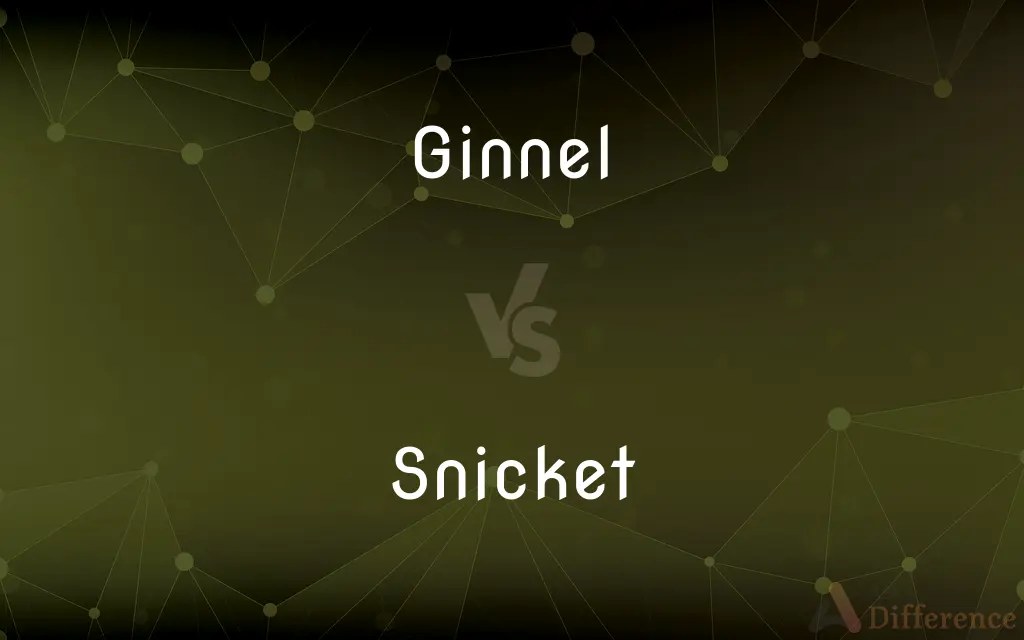Ginnel vs. Snicket — What's the Difference?
By Urooj Arif & Maham Liaqat — Updated on May 5, 2024
Both ginnel and snicket refer to narrow passageways between buildings, but "ginnel" is more commonly used in North England, while "snicket" is preferred in parts of Yorkshire and Lancashire.

Difference Between Ginnel and Snicket
Table of Contents
ADVERTISEMENT
Key Differences
A ginnel is a term used particularly in Northern England to describe a narrow alleyway or passageway between buildings. These are often found in older residential areas providing shortcuts or access between streets. On the other hand, a snicket serves a similar purpose but is more frequently used in specific regions like Yorkshire and Lancashire.
Ginnels are typically utilitarian in function, used primarily as pathways or to access rear entrances of properties. They can be covered or open to the sky. In contrast, snickets are also utilitarian but may often be less formal, sometimes partially covered by vegetation and can be less maintained.
The term "ginnel" can sometimes imply a covered or partially enclosed passageway, providing a sense of enclosure or narrowness. Whereas, a snicket might not necessarily be covered and often has a more open feel, although it is still narrow and confined between buildings or walls.
Residents in areas where ginnels are common might refer to any narrow passageway with this term, regardless of its specifics. Conversely, the use of "snicket" can often include passageways that are more irregular in paving or even semi-rural in character, linking urban areas with green spaces.
Both ginnel and snicket highlight regional linguistic diversity within English, illustrating how similar concepts can have different names depending on local dialects. However, despite their regional variations, both serve to facilitate pedestrian traffic and are integral to the urban landscapes in which they are found.
ADVERTISEMENT
Comparison Chart
Regional Usage
Predominantly in North England.
Common in Yorkshire and Lancashire.
Typical Features
Often narrow and can be covered.
Typically open, sometimes less maintained.
Function
Provides shortcuts or access between streets.
Serves similar purposes, occasionally links to green spaces.
Implication
Can imply a more urban context.
May suggest a less formal or more varied use.
Linguistic Diversity
Illustrates regional language variations in England.
Highlights specific local dialects within regions.
Compare with Definitions
Ginnel
A narrow passageway between buildings.
She took the ginnel to get to the main road faster.
Snicket
Predominantly a term from Yorkshire and Lancashire.
Everyone in the village called the alley a snicket.
Ginnel
An alley often used for rear access.
The delivery was made through the back ginnel.
Snicket
A narrow pathway between houses.
The snicket was overgrown but still passable.
Ginnel
A pedestrian shortcut in urban areas.
The ginnel behind the houses saves five minutes.
Snicket
Sometimes implies a rustic or rural pathway.
The old snicket wound through the village outskirts.
Ginnel
Sometimes covered walkways in cities.
The covered ginnel provides shelter during rain.
Snicket
Often less formal or maintained.
The snicket leading to the park was lined with wildflowers.
Ginnel
A term used predominantly in Northern England.
He referred to the alley as a ginnel, marking his northern roots.
Snicket
Can be open and lead to green spaces.
They walked through the snicket to reach the field.
Ginnel
A narrow passageway or alley often between terraced houses.
Snicket
(Northern England) A narrow passage or alley.
Common Curiosities
What is a ginnel?
A ginnel is a narrow passageway between buildings, commonly found in Northern England.
What is a snicket?
A snicket is a narrow pathway similar to an alley, typically found in Yorkshire and Lancashire.
What distinguishes a snicket from a ginnel?
A snicket might be less maintained and often links urban areas with green spaces, whereas a ginnel is typically more urban and formal.
How are ginnels used?
Ginnels are used as pedestrian paths or access routes in urban settings.
Do ginnels and snickets serve the same function?
Generally, yes, both are meant to facilitate pedestrian movement between spaces.
What materials are ginnels and snickets typically made from?
They can be paved, cobbled, or even just dirt paths, depending on their age and usage.
Why are regional terms like ginnel and snicket important?
They illustrate the linguistic diversity and cultural history of different regions.
Are ginnels always covered?
Not always, but ginnels can be either open or covered, depending on the location.
Can anyone use a snicket?
Yes, snickets are public passageways, though their maintenance can vary.
Is the term snicket used outside Yorkshire and Lancashire?
It is primarily used in these areas, though similar terms exist in other regions.
How can one identify a ginnel or snicket?
Both are narrow passageways, but local terminology and characteristics like cover or maintenance might differ.
Do property owners have to maintain snickets?
Maintenance can depend on local regulations and whether the snicket is considered public or private.
How can communities improve their local ginnels and snickets?
Communities can enhance these spaces by ensuring they are clean, safe, and well-lit.
Are ginnels safe to use at night?
Like any urban passageway, their safety can vary based on lighting and location.
What impact do ginnels and snickets have on urban planning?
They are crucial for pedestrian connectivity and urban accessibility, influencing how neighborhoods are designed and utilized.
Share Your Discovery

Previous Comparison
Prank vs. Joke
Next Comparison
Decrescendo vs. DiminuendoAuthor Spotlight
Written by
Urooj ArifUrooj is a skilled content writer at Ask Difference, known for her exceptional ability to simplify complex topics into engaging and informative content. With a passion for research and a flair for clear, concise writing, she consistently delivers articles that resonate with our diverse audience.
Co-written by
Maham Liaqat















































